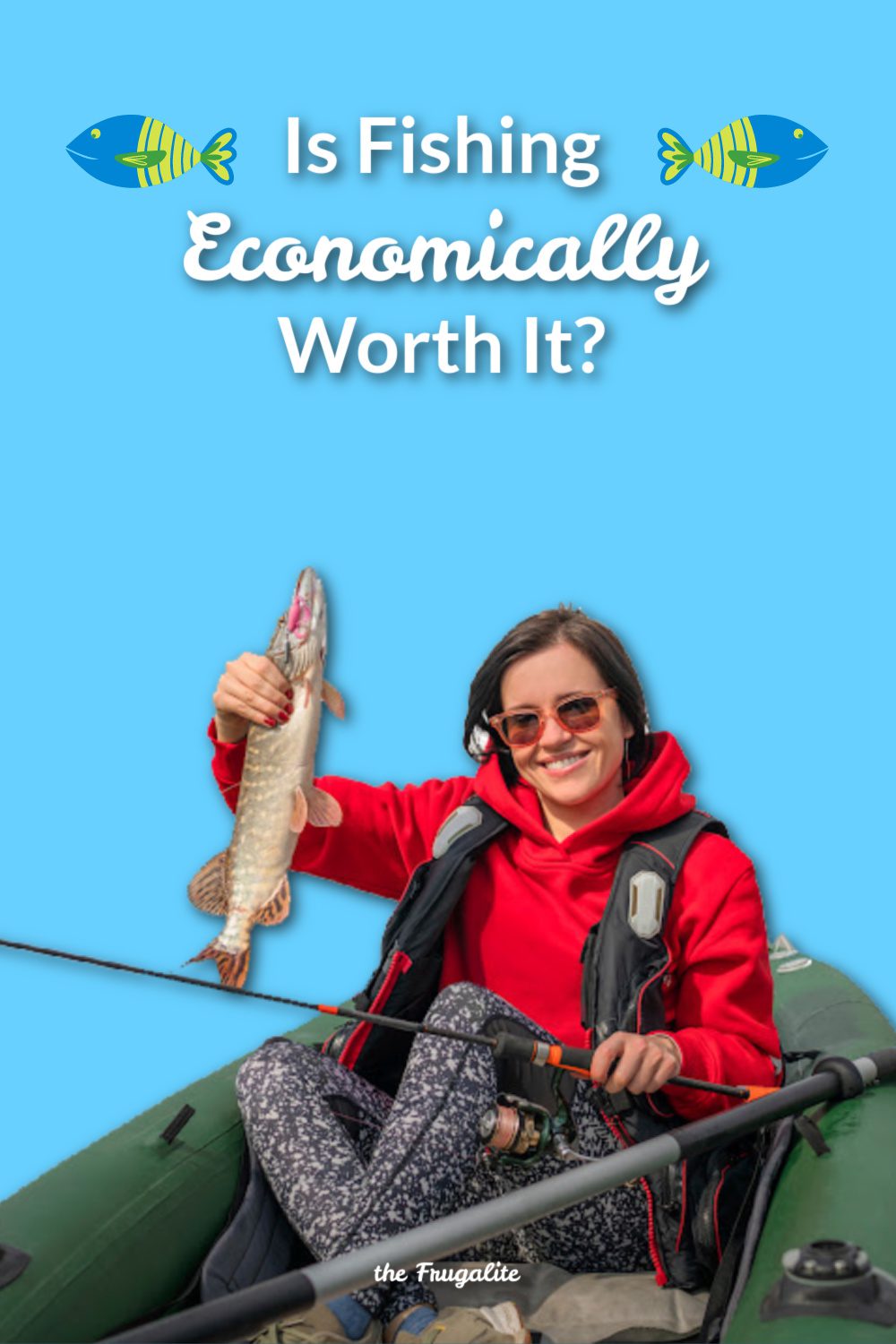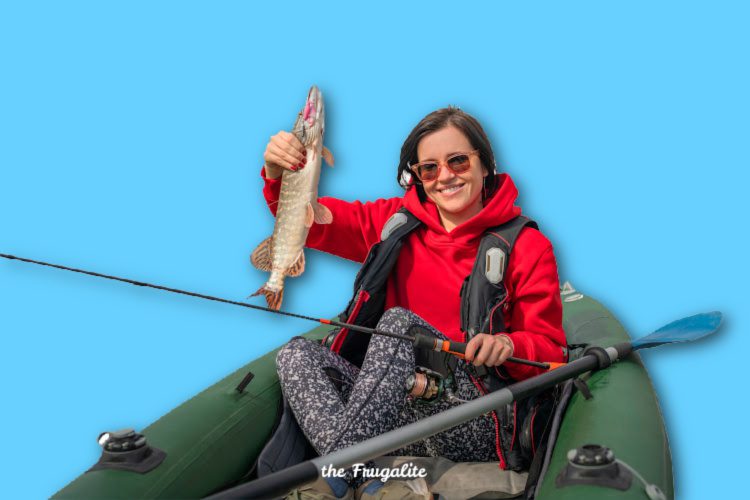(Psst: The FTC wants me to remind you that this website contains affiliate links. That means if you make a purchase from a link you click on, I might receive a small commission. This does not increase the price you’ll pay for that item nor does it decrease the awesomeness of the item. ~ Daisy)
We recently took a look at whether hunting was economically worthwhile for the Frugalite. But what about fishing? Is fishing economically worth it? I’m going to start with the assumption that you are going out into the woods or to your nearby state park to do your fishing. No paid deep-sea charters, no stocked trout ponds – none of any of that. If that is the route you are choosing to fish, you’re out to have a good time, not to save money.
There’s nothing wrong with that, of course, but for those who are seeking information on fishing to provide for their family, those options are not economically feasible.
Without further ado, let’s take a look at some of the most common fish people go out for (no, it’s not a conclusive list), and examine whether the cost of fishing for them is worth it.
Rainbow trout
The average weight of a rainbow trout is eight pounds. We’ll assume that after you filet your fish you end up with five pounds of fillets. Is the cost of fishing for a rainbow trout worth it? To start, most of the guys I know who go out for rainbow trout are fly fishermen. So, we’ll assume you’re using fly fishing equipment.
As far as fly fishing goes, I think the best bang for your buck is a Tenkara rod. Minimal gear is involved, they’re highly popular, and they work. Your collection of flies is going to run you at least $50 starting off. You’re also going to need a pair of waders.
In South Carolina, you can catch 40 fish/day, but most places only let you grab five from their waters. Let’s assume your state also allows a max of five rainbow trout per day.
If my Tenkara rod costs me $160, my flies cost me $50, and my waders cost me $140, I need to catch over $350 worth of fish to justify my expenditures. How long would this take? If I go to the grocery store, you’ll see that around $8/pound is an average price for rainbow trout. As stated above, I’ll get an average of five pounds of filet from each trout.
That would mean a single fish would be worth $40 in meat. Even if I’m only catching 3-pound rainbow, I still am getting an $8 filet from that one fish. If I can catch five 3-pound rainbow trout, that’s $45 of fish filets in a single day. This means I would need roughly eight 3-pound rainbow bag-limit days to cover my expenses.
Is that economically feasible? Absolutely. Fishing for rainbow trout is economically worth it.
Small-mouth bass
The average weight of a small-mouth bass is around four pounds. Most of the guys I know who like to go out for small mouth use spin rods. This is where you either sit there with a beer and watch a bobber, or you constantly throw and reel in a lure.
Fly fishing is the retired gentleman’s game. Spin reels are the redneck’s game.
You can go out and pick up a Zebco rod for $40. You’ll then need some hooks, stinky bait, bobbers, and maybe some lures. Let’s say that costs you another $40. Total expenditures would be $80. The small mouth guys I know typically sit on a flat bottom boat with their buddies or hang out in a lawn chair by the river bank. Let’s say you’re happy to sit on your butt on a rock.
Let’s say the average small mouth bass would run you $7 at the store (pretty typical). If I can bag 11 fish, I’ll have covered me expenditures. That can easily be accomplished within a month’s span. You’re going to need to continually buy more stinky bait and hooks, but the point is that small mouth bass fishing is still economically worth it.
Catfish
People either love or hate this fish. Personally, I prefer it. Salt, pepper, and a little lemon make for an awesome Southern treat. Let’s assume that catfish weigh an average of three pounds. I’ve caught larger, and you’ll hear of guys who bring in 30+ pound monsters, but let’s stick with three pounds.
You’ll spend somewhere around $2.00/pound for catfish in the store. Let’s assume you get a pound of catfish to eat for ever three-pound fish you catch. In my experience, catfish like stinky bait the best. I can pick up a jar of stinky bait for right around $6.00.
I’ll need a Zebco rod, my stinky bait, some hooks, and some bobbers to go out for catfish. Let’s say that costs me $60 total. Each fish I catch yields me $2.00 worth of meat. I’ll need to catch 30 catfish to begin to recoup my costs.
Is fishing for catfish economically worth it? Eventually, yes. However, this is not the most efficient use of your time if you’re going out fishing. If you can spend a bit of time fishing around a dam or some other area where the catfish tend to be monsters, you may end up with a behemoth of a fish. For the most part though, if you’re going out with the intention of saving money, I think you’d be better off fishing for something else.
Crabs
Of all types of fishing, this is my favorite. I’d consider three traps to be minimum necessary gear. You’re also going to need the string to pull your trap up, and a package of chicken necks from the grocery store. Chicken necks cost me around $6. I can buy a 100’ spool of string for around the same price. My three crab traps cost me about $15 each.
So, I’ve spent $45 in traps, $6 in string, and $6 in bait. That’s $57 in total.
All I have to do now is hang out by a pier or bridge, pulling up my traps every 15 minutes or so. It’s the best type of fishing there is. Zero stress, and a bit of adventure when the crabs are pulled up (don’t get pinched).
Let’s say that a dozen blue crabs runs you $40.
That means each crab is worth $3.33. That means I’d need 18 crabs before I break even. It depends on what your state’s crab fishing laws are, but this is most certainly achievable within a single season. With my luck, it would take me about five days of fishing an hour each to grab 18 crabs.
There’s obviously a lot of variables to consider here (as with any type of fishing), but that would mean I’d be putting in five hours for 18 crabs. Five hours for $60 of food. Not great, but it can easily be accomplished as you’re working on some other form of money-producing endeavor (e.g. work phone calls, article writing, or whatever else).
Crawdads
While it’s a blast catching these little boogers, this is one catch I don’t believe is economically worth it. There are two ways we catch these guys: by hand or with a string and a chicken neck. Neither option has ever resulted in a large enough catch to make it worth it. Let’s say the average pound of crawdads costs you $6 at the store.
I’m lucky to catch a pound of crawdads in an hour. Is $6 of meat in an hour worth it? Nope. Also, consider the effort it takes to catch two chews of food. If you’re going to be spending your money going out and fishing, I think your efforts are better spent elsewhere.
Is fishing economically worth it?
In most cases, I’d say absolutely. I didn’t cover the cost of fishing licenses here (they vary by state), but they’d obviously have to be considered as well. If you’re looking to get the most for your money, I would recommend a cheap Zebco rod, two packs of American Eagle hooks, a $2 pack of bobbers, and two cans of stinky bait.
You’ll not only catch fish, but you’ll catch fish that are worth your while as well.
What are your thoughts though? Are there other fish you believe are financially worth the effort? Other fish you think aren’t? Let us know in the comments below!
About Aden
Aden Tate is a regular contributor to TheOrganicPrepper.com and TheFrugalite.com. Aden runs a micro-farm where he raises dairy goats, a pig, honeybees, meat chickens, laying chickens, tomatoes, mushrooms, and greens. Aden has two published books, The Faithful Prepper and Zombie Choices. You can find his podcast The Last American on Preppers’ Broadcasting Network.












9 thoughts on “The Economics of Fishing”
Thanks for this information! Learning to fish is at the very top of my prepper goals this year! Thanks for giving me a good start off point and for confirming that this is a worthwhile (and cost effective) endeavor.
I appreciate your contributions to TOP, Aden, and always look forward to reading your articles.
This can also be a productive hobby and time well spent w/someone else. As well, you can knit, read… while fishing.
Thanks for the article! I used to fish frequently but quit because the public waters I went to were being so overfished. I doubt if the average guy could catch enough trout or bass to make fishing for them economically feasible. I have gone fishing quite a few times and caught nothing. Sometimes the fish aren’t biting even if you dangle food right in front of them.
Bowfishing for carp is another option. If caught in clean water and properly cleaned (mud vein removed) and smoked they are quite good. A medium sized grass carp is the best tasting carp.
I’d just be sure to a) buy a license if required – you won’t save much money paying fines and having your catch confiscated and b) ensure the waters from which you fish are safe (not polluted/contaminated).
Even if you just break even, fresh food is always better.
Rods a reels are usually a one time investment. As are waders. Often you can borrow or possibly get them second hand. The gas to drive to the fishing place should be included. But if you go with a friend or two or make it a family event it can definitely be cost effective. Up here in N.W. Montana we have a snagging season for salmon. If you are there when they’re running you can get a lot of salmon to put up. Especially if you go as a family group. Also if you consider it just getting outdoors and having a good time it’s profitable.
Today, at the Goodwill that I work at, we have two Zebco rods available. They are priced at either $4 of $5 each.
Eight pound Rainbows; four pound Smallmouths & three pound catfish! HAH! Somebody doesn’t do very much fishing. If I ever catch an 8 pound Rainbow, it’s going on the wall.
The species of fish that will make fishing economical are the panfish like Bluegills, Perch and Pumpkinseeds.
IMO, this article was terrible even though the conclusion was good.
When we did a lot of fishing, we lived in South Florida near the ocean. We already had rod ‘n reels & other equipment, including a cast-net. Our cost was the price of gasoline round-trip. One favorite spot was a small island right off the coast, only accessible during low-tide and we had to get back to shore before high tide. One trip we caught three 10-lb fish (a local fish, its name unremembered) which kept our freezer full for the month; that’s how we got through many months: what ever snagged our line. In the Fla. Keys we found various fish & lobster.
When I’m economically pursuing catfish the math is: $10 for trotline, $10 for hooks, 0$ for fish guts/roadkill, check and rebait every 24 hours=10-20 catfish@1lb+ meat each and the occasional legal snapping turtle@10lb+ meat each.